Marton
OS grid ref:- SJ850680
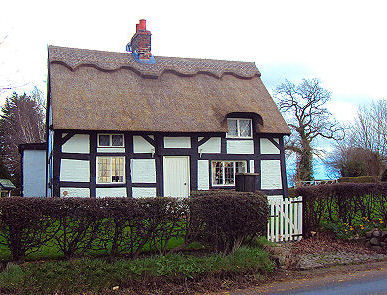
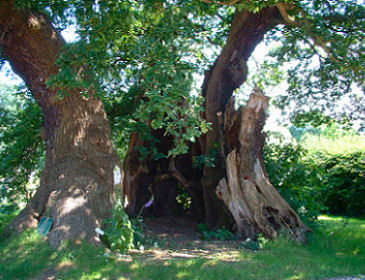 The small, attractive Cheshire village of Marton is situated on the A34 road 3 miles (5 km) to the north of Congleton.
The small, attractive Cheshire village of Marton is situated on the A34 road 3 miles (5 km) to the north of Congleton.
The Davenport Arms in the village dates back to the eighteenth century and was once part of the Capesthorne Estate. The building started its life as a farmhouse, the farmer starting to brew his own beer as a sideline until eventually it became the village hostelry.
Marton is home to the oldest oak in the county (pictured right), which has been estimated by a number of experts to be at least 1,200 years old. The Marton Oak has been measured several times in the last 200 years, the trunk was found to be an incredible 58ft in circumference before it split. It now bears the appearance of being three seperate trees, this suggestion can be ruled out because the tree has been found to have just one root system below ground. In autumn the acorns are collected and sold for 10 pence each to the benefit of the local church. The tree is situated at the end of a driveway in Marton, linking with Oak Lane.
The village's most outstanding feature is its fourteenth century timber-framed church, a Grade I listed building.
The church of St. James and St. Paul, Marton
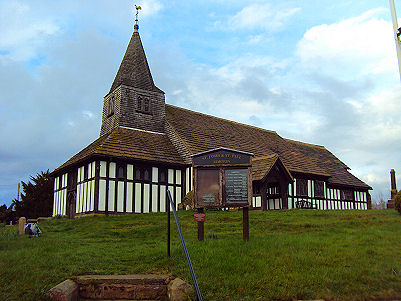
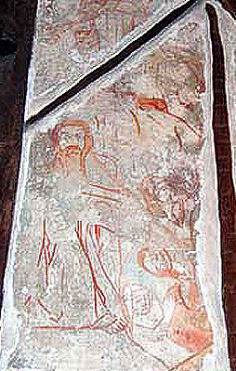 The church of St James and St Paul, which is situated to the south of the village, was founded in 1343 by local landowner Sir John de Davenport and his son Vivian.
The church of St James and St Paul, which is situated to the south of the village, was founded in 1343 by local landowner Sir John de Davenport and his son Vivian.
It originally served as a chapel. The chapel was raised to the status of parish church in 1370. The shingled belfry is a later addition and dates to around 1540. The original structure has remained untouched apart from a sympathetic Victorian restoration, when some of the windows were altered, the timbers in the tower tidied and the existing west entrance was added. A brick extension to the chancel was constructed in the twentieth century.
The church is undoubtedly one of the finest examples of the Medieval wooden church remaining in England today, architectural historian Nickolaus Pevsner referred to Marton church 'one of the architectural gems of Cheshire'.
The visitor enters the building through a beamed bell-tower, on the west of the building. Two damaged stone effigies of fourteenth century knights are situated in the belfry. The heads rest on the Davenport crest, suggesting the figures might depict the church's founders, John and Vivian de Davenport. The felon's head on the crest indicates their status as Serjeants of Macclesfield Forest. These effigies originally stood outside in the churchyard, but were later moved into the belfry to preserve them.
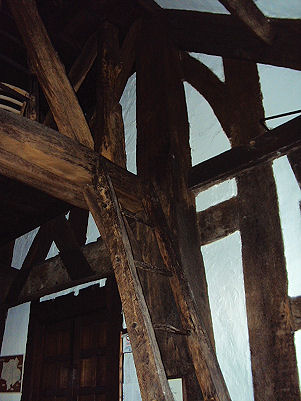 The impressive and characterful nave is supported on timber piers clustered into ocatagonal shapes.
The impressive and characterful nave is supported on timber piers clustered into ocatagonal shapes.
The pulpit carries a coat of arms and dates from 1620. There are three surviving bells, the oldest dating from the late Elizabethan period, being inscribed 'God Save the Queen and Realme 1598'. The other two bells date to 1663 and 1758.
Other features include an Elizabethan parish chest and an ancient handmade wooden ladder accessing the bell-ringing platform.
The church's west wall preserves traces of some early medieval paintings, which were discovered under plaster in 1930. The painting is triangular in shape and probably represents the Last Judgement, it is divided into sections by the timbering.
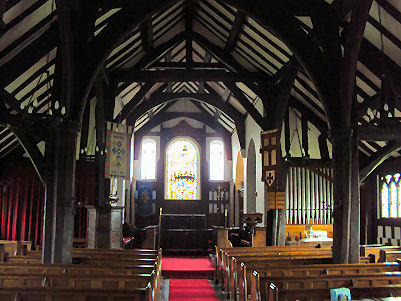 A haloed male figure with long yellow hair at the top right possibly represents Christ, and a haloed kneeling female figure opposite might represent the Virgin Mary. The bottom left panel contains figures with raised hands mainly looking towards the viewer; these possibly represent souls under judgement. Other figures carry items, perhaps instruments of the Passion.
A haloed male figure with long yellow hair at the top right possibly represents Christ, and a haloed kneeling female figure opposite might represent the Virgin Mary. The bottom left panel contains figures with raised hands mainly looking towards the viewer; these possibly represent souls under judgement. Other figures carry items, perhaps instruments of the Passion.
Also of interest inside the church is a large eighteenth century oil painting by Edward Penney of Moses and Aaron holding the Ten Commandments.
The church is reputed to be built on a pre-historic mound. A cross dating from the fourteenth or fifteenth century stands in the churchyard.
A plaque outside the church proclaims it is the oldest timber-framed church still in use in Europe.
Nearby places of interest
Capesthorne Hall The red brick hall was built in the Jacobean style between 1719 and 1732, the turrets and pinacles were added a hundred years later.
Gawsworth Hall is a late fifteenth century half timbered manor house built around a courtyard. The house belonged to the Fitton family, Earls of Macclesfield. The hall contains many fine paintings, furniture, sculpture and stained glass. An earlier house once occupied the site which dated from Norman times. This house was replaced in the 15th and 16th centuries. Building commenced in 1480 and continued in stages until about 1600. Since that time, parts of the building have been demolished, and others have been greatly altered.
Bosley Cloud lies on the Cheshire-Staffordshire border just a couple of miles to the west of the Peak District National Park. It rises to a height of 343 metres (1,125 feet).
